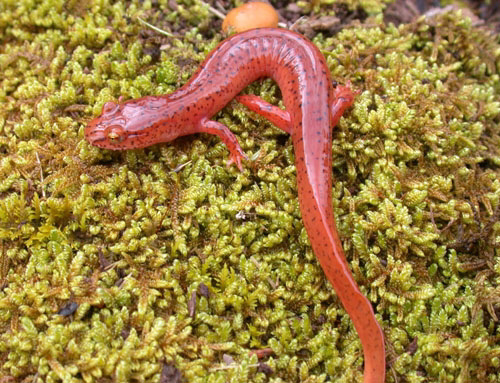The Northern spring salamander is a member of the lungless salamander family. Adult salamanders in this family do not have lungs but take in oxygen through their skin. Northern spring salamanders are smooth-skinned and are reddish orange to reddish brown. They have a dark line from eye to nostril and white bellies. They have blunt snouts. They can be 8 to 8 1/2 inches long.
The range of the northern spring salamander is a narrow band of states in the US. They are found in southwestern Maine, Vermont, New Hampshire, northwestern Connecticut and Rhode Island, New York, Pennsylvania, southeastern Ohio, West Virginia, western Virginia, eastern Tennessee and North Carolina, the eastern tip of South Carolina, and in northern Mississippi and Alabama. Northern Spring salamanders are rare in Connecticut and are limited to spotty populations in Litchfield, Hartford and Tolland Counties. They are a threatened species in Connecticut.
Adult northern spring salamanders live in the freshwater springs that give them their name. They like clean, cold, moving water and are often found under partially submerged rocks along such streams. As skin-breathers, they require highly oxygenated water. Adults are active in the warm months and semi-active over the winter in underground burrows in wet soil near a water source. They are nocturnal.
Northern Spring salamanders mate in mid-October through winter. The male and female will roll around together in the water in a courtship dance. The female lays 10 to 150 eggs individually or in small groups on the underside of a flat, submerged rock. The female guards her clutch. They hatch in late summer or early fall. The larvae remain near the hatch site for several months. They are aquatic with well developed gills. They are slender and remain white with a purple cast for up to 3 years. The color of the larvae resulted in these salamanders formerly being called purple salamanders. It takes about 4 years for the larvae to reach adulthood. Females can breed at about age 5.
Adult Northern Spring salamanders eat small insects and invertebrates and also consume smaller salamanders.
